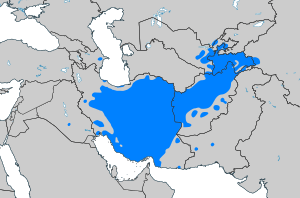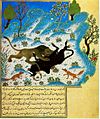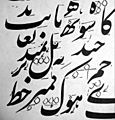Persian language facts for kids
Quick facts for kids Persian |
||||
|---|---|---|---|---|
| Farsi fa |
||||

Farsi in Persian script (Nastaʿlīq style)
|
||||
| Native to | Iran Afghanistan(as Dari) |
|||
| Native speakers | 60 million (2009) (110 million total speakers) |
|||
| Language family |
Indo-European
|
|||
| Early forms: |
Old Persian
|
|||
| Dialects |
Western Persian
Bukharic
Pahlavani
Judæo-Persian
Juhuri
Caucasian Tat
Armeno-Tat
|
|||
| Writing system | Arabic (Persian alphabet) Cyrillic (Tajik alphabet) Hebrew script Persian Braille |
|||
| Official status | ||||
| Official language in | ||||
| Recognised minority language in | ||||
| Regulated by | Academy of Persian Language and Literature (Iran) Academy of Sciences of Afghanistan |
|||
| Linguasphere | 58-AAC (Wider Persian) > 58-AAC-c (Central Persian) | |||

Approximate extent of the Persian language area. Map includes all three dialects of Persian.
|
||||
|
||||
Persian, also known as Farsi, is a language from the Iranian language family. It is the official language in Iran, Afghanistan, and Tajikistan. Many people also speak Persian in nearby countries like Pakistan, Uzbekistan, and Azerbaijan.
People who have moved from Central Asia to Russia also speak Persian. In the past, many of these areas were part of the large Persian Empire. Until 2006, Persian was even taught as a second language in schools in Pakistan.
Persian has several different forms, called dialects. In Iran, it is officially called Farsi. In Afghanistan, it is called Dari or Farsi. In Tajikistan, it is known as Tajiki. The way the language is written and used in books is a bit different in each country. However, people from these countries can usually understand each other when they talk.
Persian in Iran has some words from French. In Tajikistan, it has many words from Russian.
Contents
Persian Alphabet and Writing
The Persian alphabet used in Iran and Afghanistan looks a lot like the Arabic alphabet. Even though they look similar, Persian and Arabic are from different language families. This means their vocabulary (words) and grammar (how sentences are put together) are very different.
Since the 1930s, in countries that were once part of the Soviet Union, like Tajikistan and Uzbekistan, Persian has been written using the Cyrillic alphabet. This is the same alphabet used for Russian. Before this change, all Persian speakers used the Arabic alphabet.
Here are the letters of the Persian alphabet:
ا ب پ ت ث ج چ ح خ د ذ ر ز ژ س ش ص ض ط ظ ع غ ف ق ک گ ل م ن و ه ی
History of the Persian Language
Persian is a very old language with a rich history. Experts in linguistics (the study of language) divide its history into three main periods.
Old Persian
Old Persian was spoken during the first Persian Empire. This empire was ruled by the Achaemenid kings, like Cyrus and Darius the Great. This empire lasted from the 6th century BC until Alexander the Great conquered it.
Middle Persian
The second Persian Empire was led by the Sassanian kings. They ruled from the 2nd century AD until the Muslim conquest of Iran by the Arabs in the 7th century. During this time, people spoke Middle Persian, also known as Pahlavi.
Modern Persian
New or Modern Persian is the language spoken today. It was first written down in the 9th century during the Samanid Empire. This was the first Muslim Persian kingdom, and it was based in Central Asia.
Some of the earliest writers in New Persian were famous poets. These include Rudaki and Ferdowsi. Ferdowsi wrote a very long epic poem called the Shahname, which means Book of Kings. This epic tells stories and myths from before the Arabs conquered Persia.
Many other famous Persian writers were also poets, such as Saadi, Hafez, and Rumi. The Persian language has been very important for literature throughout history. After Arabic, it was the second most common language used for writing in Muslim countries, especially in the East.
Sample Phrases
Here is an example of Persian text and its English translation:
|
|
Related Pages
Images for kids
-
An Old Persian inscription written in Old Persian cuneiform in Persepolis, Iran
-
Middle Persian text written in Inscriptional Pahlavi on the Paikuli inscription from between 293 and 297. Slemani Museum, Iraqi Kurdistan.
-
Kalilah va Dimna, an influential work in Persian literature
-
Persian poem, Agra Fort, India, 18th century
-
Persian poem, Takht-e Shah Jahan, Agra Fort, India
-
Ali-Akbar Dehkhoda's personal handwriting, a typical cursive Persian script
See also
 In Spanish: Idioma persa para niños
In Spanish: Idioma persa para niños











